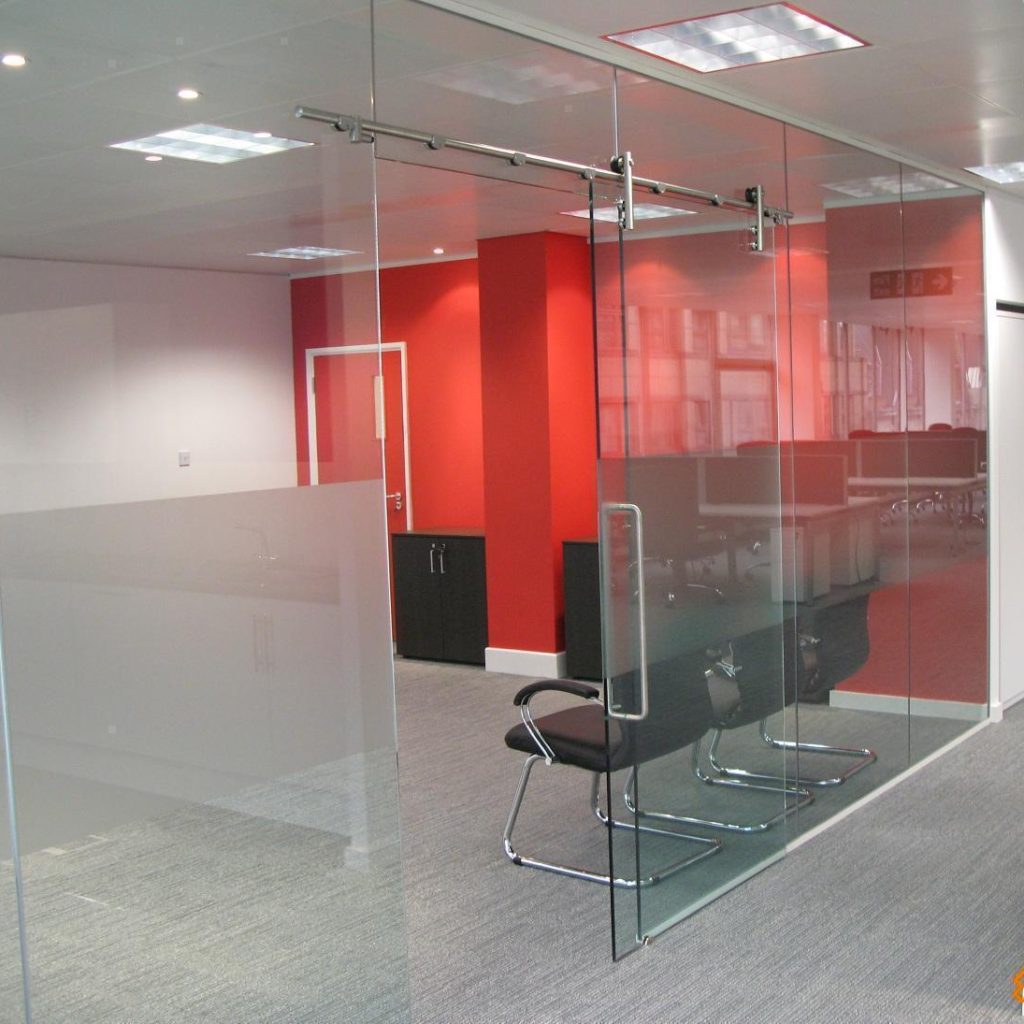
Frameless sliding glass doors are transforming the way businesses design their spaces, offering a balance of openness, privacy, and modern appeal. They let in abundant natural light, improve flow between areas, and save space compared to traditional doors, making them especially valuable in offices, retail stores, hotels, and other commercial environments. Unlike conventional framed systems, frameless designs use strong glass panels with discreet tracking, creating a seamless finish that elevates any setting.
In this article, you’ll learn what frameless sliding glass doors are, how they work, the different ways they can be used in commercial interiors, the benefits they provide, and what to consider before choosing them.
What are Frameless Sliding Glass Doors?
Frameless sliding glass doors are large glass panels that move horizontally along a track without bulky frames around the edges. Instead, they rely on toughened or laminated safety glass and precision-engineered hardware to ensure strength and stability. This design creates an almost invisible barrier, allowing spaces to feel brighter and more connected while still providing separation when needed.
Unlike framed sliding doors, which use visible aluminium or steel profiles, frameless systems remove that bulk to achieve a minimalist, professional finish. They also differ from traditional hinged doors, which swing open and require extra clearance space by gliding smoothly along discreet tracks. They are commonly integrated seamlessly with frameless glass partitions and used as internal partitions in offices and coworking spaces, as shopfronts in retail environments, or as sliding room dividers in hotels and hospitality venues. With options for acoustic insulation, custom branding, and flexible layouts, frameless sliding glass doors bring both style and function to modern commercial spaces.
How Frameless Sliding Glass Doors Work
1. Individual Panels: The system consists of several panels made from tempered or laminated safety glass that are completely free of frames.
2. Concealed Tracks and Wheels: Each panel slides on concealed rollers housed in the top and bottom tracks. High-quality wheels and pulleys ensure smooth, silent movement, while recessed or flush thresholds reduce trip hazards and provide a clean, uninterrupted floor line.
3. Glazing Channels: The glass panels are securely held within slim glazing channels integrated into the tracks. These channels guide the panels, keeping them perfectly aligned and stable as they slide.
4. Manual Operation: Operation begins by unlocking and sliding the first panel at the end of the track. It rotates to a 90-degree position, held in place by a magnetized stop. The remaining panels follow, sliding along the track and stacking neatly at the side.
5. Stacking Mechanism: When fully opened, the panels stack tightly against each other, with each taking up only about 1 inch of space. Depending on the configuration, systems can feature single sliders, bi-parting sliders, or multi-track layouts where several panels stack in sequence.
6. Weather Seals: Translucent, UV-protected seals run between panels and inside the tracks to block air, moisture, and dust. In higher-performance systems, optional insulation and solar-control glazing improve thermal efficiency and comfort.
7. Safety Features: All panels use toughened or laminated safety glass to comply with commercial standards. Flush bottom tracks minimize tripping risks, while the system’s durable hardware and strong anchoring resist wind load and heavy daily use.
Key characteristics:
1. Unobstructed Views: The frameless design removes visual barriers, maximizing natural light and creating uninterrupted views.
2. Space Efficiency: Panels slide parallel to the wall, saving valuable floor space compared to swinging doors.
3. Versatility: Users control how much to open, sliding just one or two panels for ventilation or stacking the entire system for wide, open access.
4. Customization: These doors are highly customizable in panel size, number of tracks (panels can stack or slide in multiples), choice of glazing like tempered, laminated, sometimes triple glazing, finishes, handle designs, and security features.
Why Commercial Spaces Choose Frameless Sliding Glass Doors
1. Space-saving in high-footfall areas: Since the panels slide rather than swing, they eliminate the need for clearance space.
2. Enhance openness and light: With no bulky frames, it creates a brighter, more welcoming environment that feels open and connected.
3. Professional and contemporary aesthetics: Frameless sliding glass doors bring a refined, modern look to commercial spaces, helping businesses project a professional image.
Where Frameless Sliding Glass Doors Work Best in Commercial Settings
1. Offices: Ideal for meeting rooms, breakout spaces, and executive zones, they create private areas without blocking light or making spaces feel closed in.
2. Retail: Perfect for store entrances and product displays, they attract attention while maintaining a welcoming flow for customers.
3. Hospitality: Used in hotel lobbies, cafés, and restaurants, they help define spaces elegantly while ensuring easy movement in busy areas.
4. Leisure: In gyms, spas, and wellness centres, they separate zones such as workout areas or treatment rooms while maintaining a calming feel.
5. Healthcare: Suitable for clinics and consultation rooms, they provide privacy while ensuring spaces remain hygienic, bright, and accessible.
Comparing Frameless Sliding Glass Doors with Other Options
When choosing glass systems for commercial spaces, it helps to weigh frameless sliding glass doors against other common alternatives:
| Comparison | Frameless Sliding Glass Doors | Alternative Option |
| Sliding vs. Hinged Systems | Panels slide along a track with no swing clearance needed. | Hinged doors require space to swing open and close. |
| Frameless vs. Framed Sliding Glass Doors | No visible frames, offering uninterrupted views and a lighter aesthetic. | Framed doors use aluminium or steel edging, which can block sightlines. |
| Sliding Doors vs. Fixed Partitions | Panels can open fully, partially, or stay closed depending on need. | Fixed partitions create permanent divisions with no flexibility. |
Key Considerations Before Installing Sliding Glass Doors
1. Glass options: Businesses can choose from clear glass for maximum transparency, frosted or tinted finishes for added privacy, or acoustic glass for noise reduction.
2. Durability in high-traffic areas: Commercial environments like offices, hotels, and retail spaces demand glass doors that can withstand constant use. Tempered or laminated glass ensures strength, while quality tracks and hardware prevent wear over time.
3. Safety and compliance: These systems meet strict building regulations, with features such as fire-rated glass for accessibility and impact resistance. Flush bottom tracks reduce trip hazards, and laminated glass provides added protection against breakage.
4. Maintenance and cleaning needs: Frameless sliding doors are simple to maintain. Regular wiping keeps them looking pristine, and occasional checks on tracks ensure smooth, effortless operation without rigorous upkeep.
5. Customisation for branding or privacy: Glass panels can be finished with frosting, tinting, or designs that highlight company branding.
Final Thoughts
Frameless sliding glass doors bring together functionality and style, making them a versatile solution for offices, retail stores, hotels, leisure spaces, and healthcare facilities. They enhance natural light, save valuable floor space, and create a modern, professional look that works across different industries.
For the best results, these doors work well as part of a broader partitioning strategy, combining frameless glass partitions to define zones and improve flow.
FAQs
Yes. Frameless sliding glass doors can integrate with automation systems, making them ideal for entrances, lobbies, and other high-traffic areas where hands-free access improves flow and accessibility.
With acoustic glass options and specialised seals, frameless sliding glass doors can significantly reduce noise, making them effective for offices, meeting rooms, healthcare facilities and other busy commercial spaces.
With quality materials and professional installation, frameless sliding glass doors can last decades. Regular cleaning and light maintenance of tracks and seals ensure smooth, long-term operation.
Absolutely. The glass panels can be frosted, tinted, or etched with logos, patterns, and designs.
Modern frameless sliding systems can include double glazing, UV-protected seals, and thermally efficient glass. These features help regulate temperature, reduce heat loss, and support energy savings compared to standard glass.














